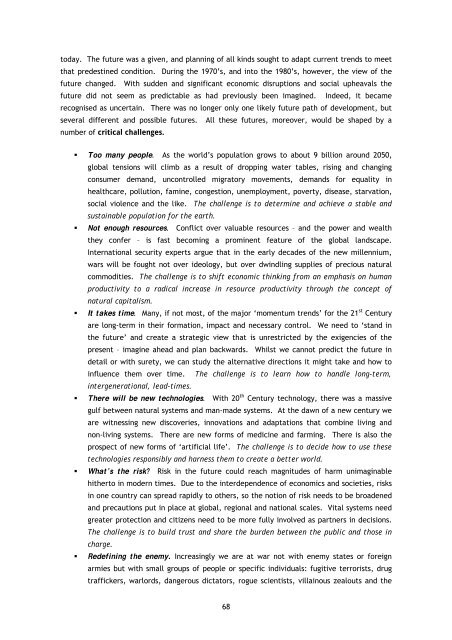TWICE THE SIZE - DIT Update - Dublin Institute of Technology
TWICE THE SIZE - DIT Update - Dublin Institute of Technology
TWICE THE SIZE - DIT Update - Dublin Institute of Technology
Create successful ePaper yourself
Turn your PDF publications into a flip-book with our unique Google optimized e-Paper software.
today. The future was a given, and planning <strong>of</strong> all kinds sought to adapt current trends to meet<br />
that predestined condition. During the 1970’s, and into the 1980’s, however, the view <strong>of</strong> the<br />
future changed. With sudden and significant economic disruptions and social upheavals the<br />
future did not seem as predictable as had previously been imagined. Indeed, it became<br />
recognised as uncertain. There was no longer only one likely future path <strong>of</strong> development, but<br />
several different and possible futures. All these futures, moreover, would be shaped by a<br />
number <strong>of</strong> critical challenges.<br />
Too many people. As the world’s population grows to about 9 billion around 2050,<br />
global tensions will climb as a result <strong>of</strong> dropping water tables, rising and changing<br />
consumer demand, uncontrolled migratory movements, demands for equality in<br />
healthcare, pollution, famine, congestion, unemployment, poverty, disease, starvation,<br />
social violence and the like. The challenge is to determine and achieve a stable and<br />
sustainable population for the earth.<br />
Not enough resources. Conflict over valuable resources – and the power and wealth<br />
they confer – is fast becoming a prominent feature <strong>of</strong> the global landscape.<br />
International security experts argue that in the early decades <strong>of</strong> the new millennium,<br />
wars will be fought not over ideology, but over dwindling supplies <strong>of</strong> precious natural<br />
commodities. The challenge is to shift economic thinking from an emphasis on human<br />
productivity to a radical increase in resource productivity through the concept <strong>of</strong><br />
natural capitalism.<br />
It takes time. Many, if not most, <strong>of</strong> the major ‘momentum trends’ for the 21 st Century<br />
are long-term in their formation, impact and necessary control. We need to ‘stand in<br />
the future’ and create a strategic view that is unrestricted by the exigencies <strong>of</strong> the<br />
present – imagine ahead and plan backwards. Whilst we cannot predict the future in<br />
detail or with surety, we can study the alternative directions it might take and how to<br />
influence them over time. The challenge is to learn how to handle long-term,<br />
intergenerational, lead-times.<br />
There will be new technologies. With 20 th Century technology, there was a massive<br />
gulf between natural systems and man-made systems. At the dawn <strong>of</strong> a new century we<br />
are witnessing new discoveries, innovations and adaptations that combine living and<br />
non-living systems. There are new forms <strong>of</strong> medicine and farming. There is also the<br />
prospect <strong>of</strong> new forms <strong>of</strong> ‘artificial life’. The challenge is to decide how to use these<br />
technologies responsibly and harness them to create a better world.<br />
What’s the risk? Risk in the future could reach magnitudes <strong>of</strong> harm unimaginable<br />
hitherto in modern times. Due to the interdependence <strong>of</strong> economics and societies, risks<br />
in one country can spread rapidly to others, so the notion <strong>of</strong> risk needs to be broadened<br />
and precautions put in place at global, regional and national scales. Vital systems need<br />
greater protection and citizens need to be more fully involved as partners in decisions.<br />
The challenge is to build trust and share the burden between the public and those in<br />
charge.<br />
Redefining the enemy. Increasingly we are at war not with enemy states or foreign<br />
armies but with small groups <strong>of</strong> people or specific individuals: fugitive terrorists, drug<br />
traffickers, warlords, dangerous dictators, rogue scientists, villainous zealouts and the<br />
68








